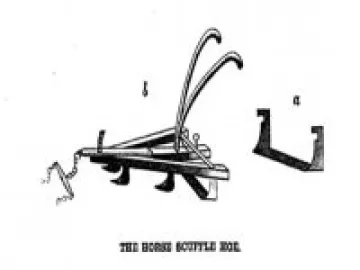Garden Tools
Two hundred years ago, advertisements by nurserymen rarely mentioned the tools that they stocked, generally referring to 'implements' of all kinds, although in 1802 James Stanley in Manchester advertised 'Spades, Hoes, Rakes, Lines, Pruning Knives, Garden Scythes and Sheers'. So it is useful to have the information from the Caldwell ledgers and the range of items that they stocked can be a bit surprising.
They didn't just have rakes – they had garden rakes with as few as 8 and as many as 30 teeth. They had Dutch hoes, small hoes, large hoes, triangle hoes, 5 inch hoes, 7 inch hoes, even 28 inch hoes. They had all sorts of knives, pruners, pruning saws, scissors and shears. Some of them have the name of the make – like the Stockton Heath spade. If you want to know more about all the tools and what they were used for, you can find out in John Loudon's Encyclopaedia of Gardening.
But they also had some implements with which you won't be familiar – scythes, strickles and scuffles.
It is important to remember that there was not the distinction between horticulture and agriculture two hundred years ago that there is today. The land-owning gardener would also have a home farm, and it can be difficult to know whether some seeds were being bought for the kitchen garden or the farm. It is the same with some of the tools.
Scythes, strickles and stones
In the days before the lawnmower (which wasn't invented until 1830), scythes were used to cut grass. But they were also used to cut cereal crops. And they could be dangerous. In his Gardener's Dictionary in 1754, Phillip Miller referred to someone whose leg had been cut to the bone by a scythe carelessly wielded while mowing grass.
Scythes were often sold together with strickles and stones. Strickle had two meanings. Often it referred to a stick which was used to level off corn in a bushel container: in Cheshire it meant this, but also 'the hone generally fastened to the scythe for sharpening purposes'. In June 1790, John Arden of Ashley purchased 1 best garden scythe; 4 strickles and 4 stones. Because this was a garden scythe, it would seem likely that the strickles were to sharpen the scythe, but stones were used for sharpening too, so perhaps the stone sharpened the strickle, which in turn sharpened the scythe.
Scuffles
The Scuffle was sometimes referred to as a Scuffle-hoe which gives a very wrong impression of it as if was a big piece of equipment pulled by a couple of horses. In 1810 it was described as 'of considerable importance in agriculture. It is excellent in cleaning beans or peas stubble, previous to their being sown with wheat. It is also very useful in destroying weeds upon fallows, where ploughing might be injurious, either from the land being too moist or very light.
'No instrument is better adapted for cleaning land that has been sown with garden peas, previous to its being ploughed, harrowed, rolled, and drilled with turnip or rapeseed in the latter end of July, or beginning of August.
'One man, with two horses, scuffles about six or eight acres per day. After the land has been scuffled, it should be harrowed twice or thrice, and the weeds collected in heaps and burnt.' (Minutes in Agriculture and Planting, by William Amos).

This picture of the Scuffle-hoe appeared in the American publication The Horticulturist, and Journal of rural art and rural taste in September 1846.
Bass mats
Bass mats were repeatedly ordered by Caldwell's customers. All nurserymen stocked them. They were sometimes referred to as Russian or Archangel mats because most of them were manufactured in Russia and shipped out of Archangel. They had multiple uses – as padding, protection from both cold and heat, and for string.
The mats were made from the inner bark of the European lime tree (Tilia europaea) and came in different sizes. They were woven, so it was possible to pull the threads, or strings, cutting off the required length, for tying. Abercrombie described them as the cheapest and handiest for gardeners who needed to bind grafts, tie flower stalks to canes, or tie the leaves of vegetables together to promote blanching – or just generally tie up anything that needed tying.
Bass mats continued to be popular for decades, and we wonder when they ceased to be sold?
